In volume recruitment, employers are very dependent on labor market shifts. We saw it when Covid hit and there were suddenly too many candidates for too few roles, and we see it again now, where there are too many open roles and too few candidates.
What this means is that companies need to always be prepared to scale volume hiring operations up and down to accommodate the changes in labor supply and demand.
Yet, many companies in the volume hiring space – from retailers to contact centers and quick service restaurants – still rely on manual recruitment processes and think that the only way to improve hiring operations is to increase their recruiter headcount.
At Harver, we believe that the way forward for volume hiring organizations that want to scale recruitment operations is an end-to-end digital hiring process where all manual tasks that don’t require real-time human input are automated.
This starts with gaining visibility over the bigger picture, from existing processes and tools to data governance.
What’s in?
Like what you see?
Don’t miss out. Subscribe to our quarterly digest to get the latest TA and TM resources delivered right to your inbox.
Main challenges in volume hiring
- Sourcing candidates
When you do volume hiring, you’re recruiting hundreds and thousands of candidates every month, meaning you can’t afford to manually source them. To scale sourcing you can expand your channels, or increase your recruiter headcount, but these tactics won’t help you work more efficiently or more cost-effectively in the long term.
- Screening candidates
All candidates look the same on paper, making your decision of who to take forward or not, tough. In order to make fair, unbiased hiring decisions, you need to base your candidate selection on hard data that is predictive of success in the job.
You can’t rely on recruiters to make the decision to move a candidate to the next stages of the process without the right technology and processes in place. Not only is it overwhelmingly time-consuming, but it’s also prone to bias.
- Scheduling interviews
In volume hiring, scheduling interviews, and following up with candidates is one of the most time-consuming tasks that add little value and heavily burdens recruiters.
At scale, moving candidates from one column to another in an ATS and reaching out to them one by one, then going back and forth with hiring managers and candidates to make sure their schedules are synchronized, slows down your hiring process at a time when it needs to be fast and efficient.
- Interpreting screening and assessment data
In regular recruitment, you can afford to take a few minutes per candidate to look at their assessment results and interpret the score, then decide whether the candidate is a good fit or not. In volume hiring, when you’re dealing with hundreds of candidates, doing this manually is not an option.
Improving efficiency in volume hiring operations
The challenges mentioned above are common bottlenecks in large organizations where recruiters rely on outdated processes and tools. But they’re also common in companies where the recruiting tech stack was assembled on the go, in the rush to “go digital”.
To tackle these challenges and improve operations in volume hiring, you need to focus on three main areas:
- Hiring process, which includes both the recruiter and the candidate experience
- Tools or tech stack, which needs to work in your favor, not against you
- Metrics and KPIs, which need to help you spot areas of operational inefficiency
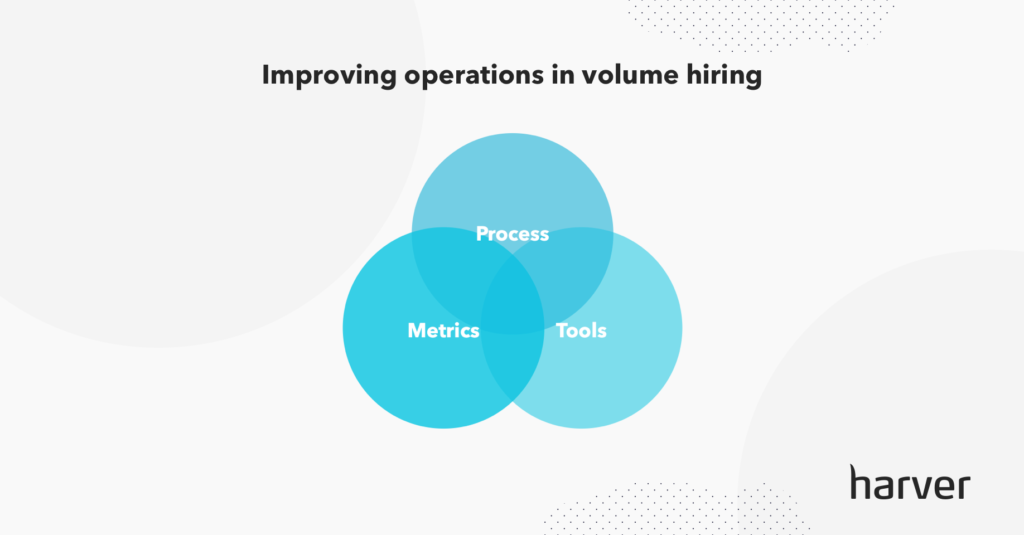
Let’s discuss these, one by one, in the next section.
The tech stack
The tools you choose for your recruitment tech stack need to be fully integrated to help you streamline your process and ensure a smooth experience for both recruiters and candidates.
In practice, this means that you need to consider your volume hiring challenges and needs when selecting a sourcing solution, an ATS, or an onboarding tool. The same applies to the recruitment software: it needs to be tailored to your specific needs.
Volume hiring is different from regular recruitment. Although you can perform most tasks with tools that are designed for regular hiring, if your goal is to drive operational efficiency, then you need software that’s built for volume recruitment.
At Harver, we create recruitment software that’s purpose-built for volume hiring. This means that everything that we do, from product design and user experience to integrations with ATSs is engineered with the specific challenges of volume hiring in mind.
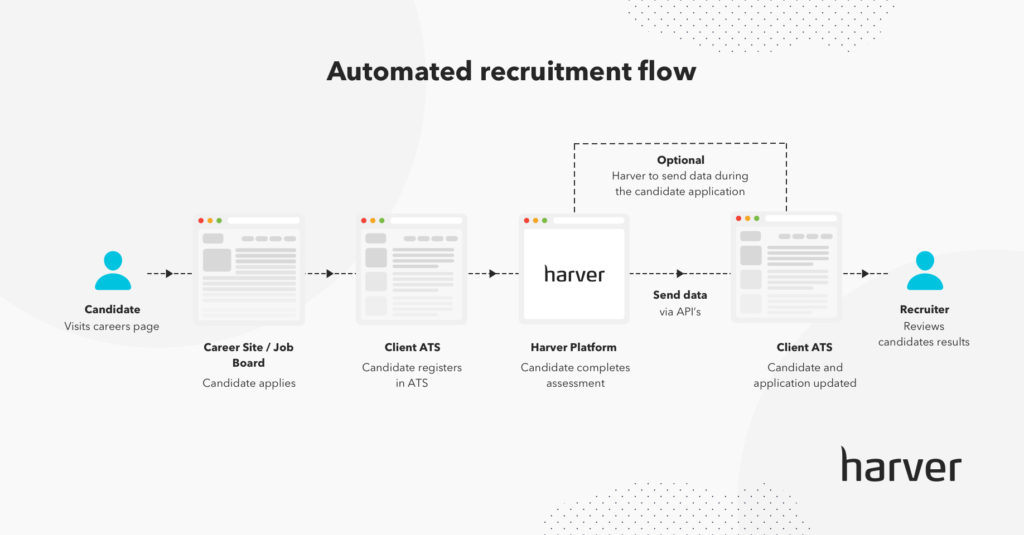
Our solution is designed to help streamline the recruitment process by turning it into an end-to-end digital experience that’s fast, fun, and fundamentally fair.
We do this by focusing on four building blocks: matching technology, process automation, candidate experience, and business intelligence.
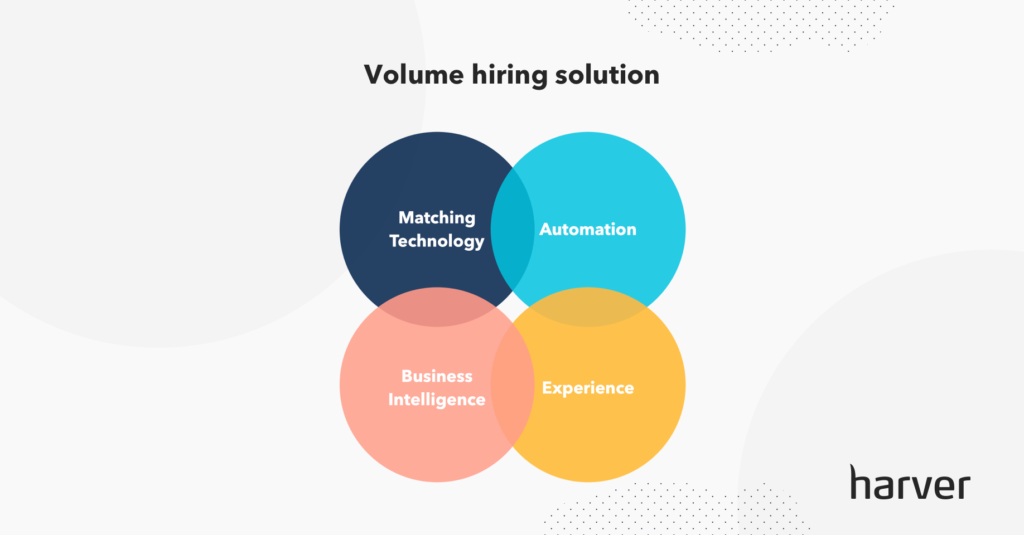
These four building blocks can be customized to serve your specific needs.
For example, the matching algorithms can be adjusted to help you filter out candidates if you’re dealing with labor supply that exceeds your demand; the automation can go as deep as you want it to, as the Harver platform can take over most of the steps in the recruiting process, from apply to hire.
The dashboards available through the BI suite can be tailored to display the most important KPIs, and the candidate experience can be designed to inform the candidates while showcasing your company culture and employer brand.
Here’s how an end-to-end volume hiring solution such as Harver can help improve the efficiency of your recruitment process.
Ready to transform your hiring process?
The process
We’ve briefly touched upon this in the section above. To improve operational efficiency in volume recruitment, you need a process that’s fully streamlined and automated.
This starts with looking at your current hiring process and mapping the candidate journey. Once that is clear, you can look at which specific steps can and should be automated to deliver a smooth and engaging experience to both recruiters and candidates.
Scaling sourcing in volume recruitment
Searching, identifying, and reaching out to potential candidates to fill both your talent pipeline and your open roles isn’t something you can do manually at scale. When you’re sourcing hundreds, if not thousands of applicants regularly, knowing where to find them is key. Which recruitment channels yield the best candidates. How do your top candidates find your job advert? Where do they come from?
You need technology that can take this real-time recruitment data, analyze it and display the results in an easy-to-understand insights dashboard, so you can, at a glance, determine which recruitment sources gave you the best performing employees.
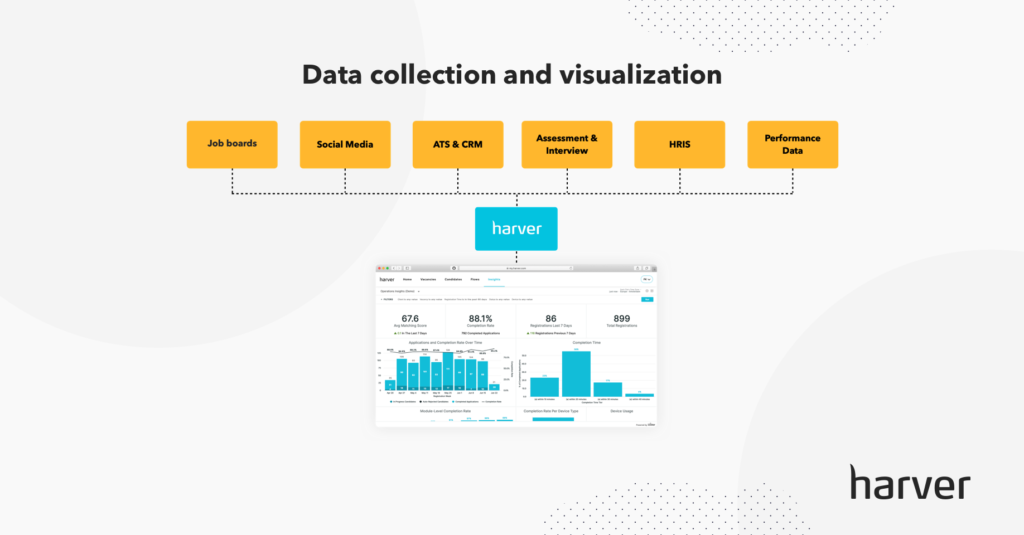
Candidate routing
When you’re sourcing candidates for low complexity, entry-level roles, you often have few requirements of the candidates, meaning if an applicant doesn’t meet your specifications for one role, don’t discount them for further roles within your organization.
In fact, when you’re hiring at scale in a tight labor market, keeping an interested, steady supply of top talent within your talent pool ready to feed into your volume hiring process is essential, especially when you’re sourcing applicants for multi-locations, such as retail and QSR. If you don’t, they’ll get snapped up by the competition.
Routing high-quality candidates to different open roles is key to keeping them in your organization, plus it means you don’t have to start sourcing from scratch every time you need to fill an open position. During the application stage, gauging applicant interest in applying to other locations is essential to maximizing this strategy, perhaps you might offer an incentive of an increased likelihood of hiring if they are open to it.
After assessing candidates for company and job fit, the Harver platform allows applicants to apply to all your open positions, at all available locations, at the same time.
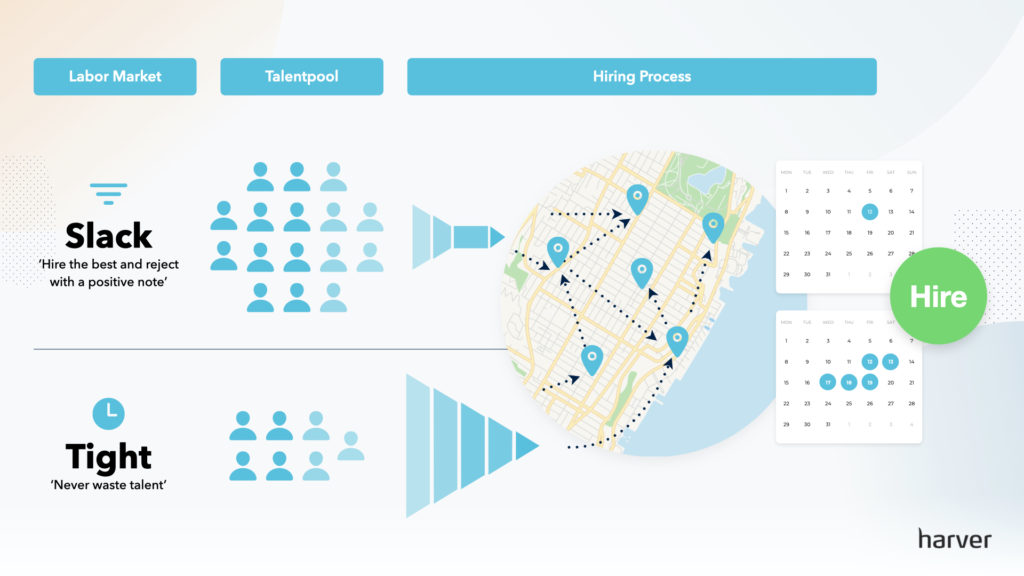
Scaling screening in volume hiring
Automating slow and ineffective manual candidate screening processes not only allows you to deal with fluctuating recruitment needs without having to increase and decrease recruiter headcount, but it also allows you to volume hire more efficiently.
There should be just two stages of the recruitment process that require actual human intervention – the interview and making the hiring decision, every other stage can and should be, automated.
Harver provides scientifically validated pre-employment assessments that are both fully automated and integrated into your job application flow.
Our software does the heavy lifting for you in terms of selling the role and managing candidate expectations through a situational judgment test (SJT), and evaluating, assessing, and selecting suitable candidates through personality assessments, multitasking tests, or live chat support simulation tests.
Utilizing technology to help select the right candidates for your open roles, not only synchronizes stage progression, but it increases the chances of new hire success, reduces early employee attrition, and reduces instances of bias in the selection process.
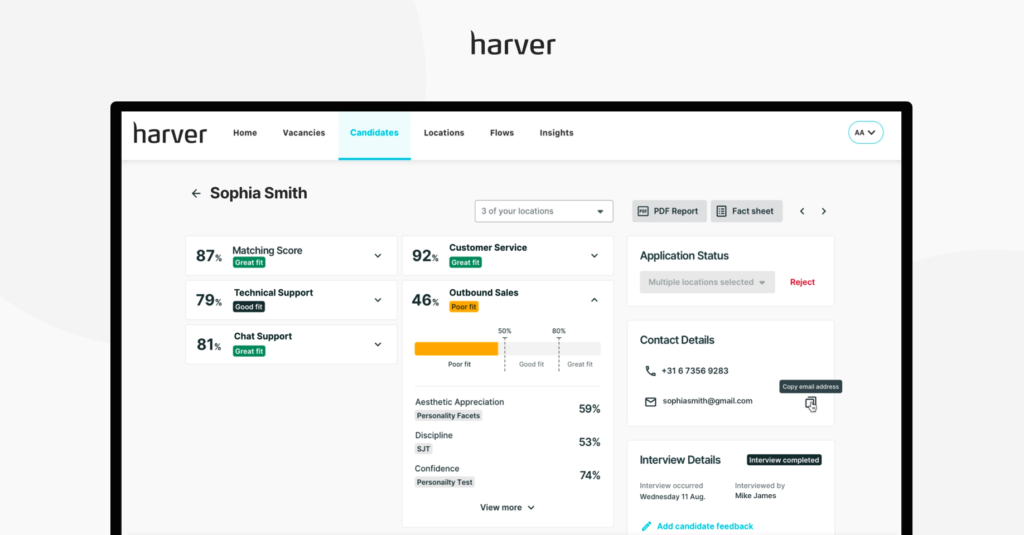
Matching technology
Matching technology enables you to scale screening efficiently by building speed and accuracy into your recruitment process.
The Harver two-way matching framework, for example, rather than focusing on your vacancy, uses a combination of pre-employment tests to assess applicants across a variety of skills and personality traits and characteristics, returning a matching score for each candidate against a variety of open positions.
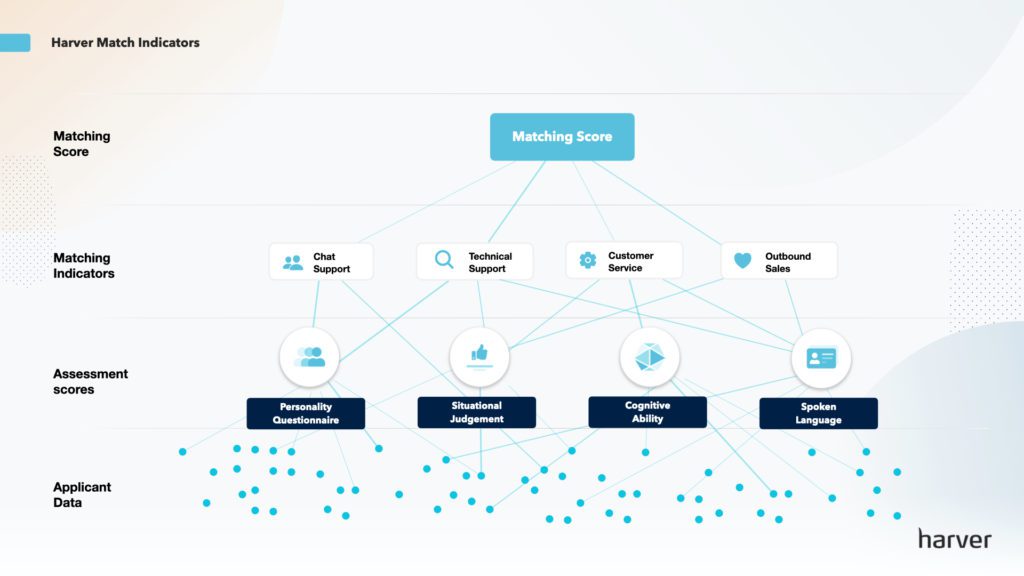
Auto-progression
Don’t forget to include auto-progression in the recruitment funnel to progress candidates who fit your selection criteria automatically to the next stage. You don’t want to lose your top talent due to a lengthy hiring process or making them wait for manual confirmation by a recruiter at the end of each stage to progress to the next one.
Pre-determine what a top employee in your organization looks like, and use them as a benchmark against which applicants are assessed. Scores from applicants’ pre-employment assessments can be tied to stage progression through your ATS, with successful candidates progressing swiftly and smoothly all the way from sourcing to interview without a single recruiter being involved.
When you’re scaling operations in volume recruitment, it’s imperative your recruitment machine is operating 24/7 to snare the top talent quickly and efficiently, and you can’t do that if it relies on manual progression.
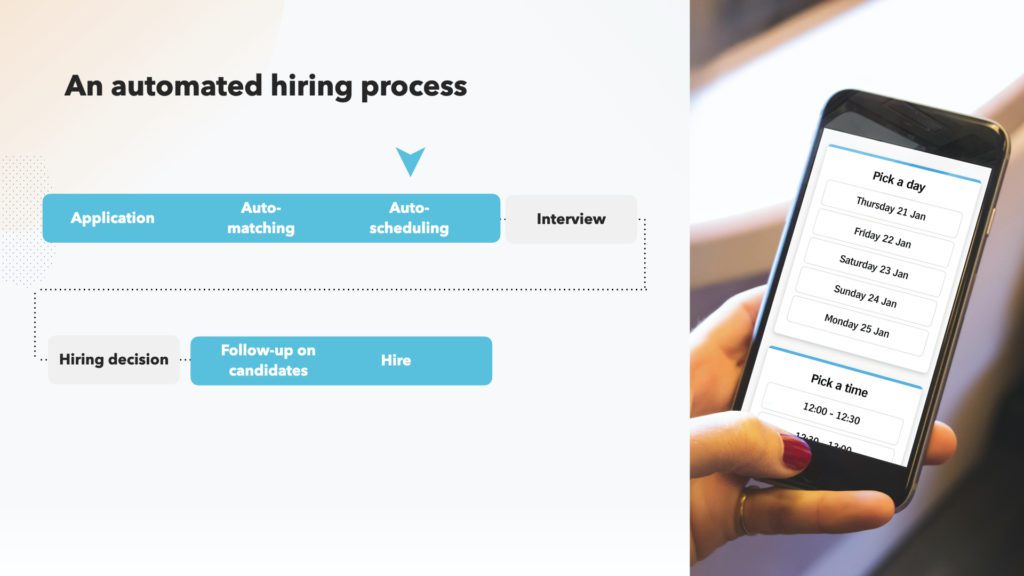
Scaling interview scheduling in volume hiring
Interview scheduling is notorious for causing the biggest bottleneck when hiring at scale and is often the reason for a lengthy time to hire.
Going back and forth on email trying to find a time that works for both interviewer and candidate, and then manually notifying the talent acquisition team of scheduled interviews, significantly slows the flow right down, not to mention giving the wrong impression of your organization to the applicant that it’s disorganized or low tech.
By providing successful candidates, i.e. those who meet your pre-determined qualifications or benchmark scores in the pre-employment assessments, the opportunity to automatically self-schedule an interview with recruiters or your hiring manager from set times in their calendar, significantly reduces bottlenecks at this late stage in your recruitment process.
Candidates simply select a time and date for an interview that suits them, and the interview meeting details are sent, automatically, to both the candidate and the recruiter’s calendar. You can also automate reminders to be sent too.
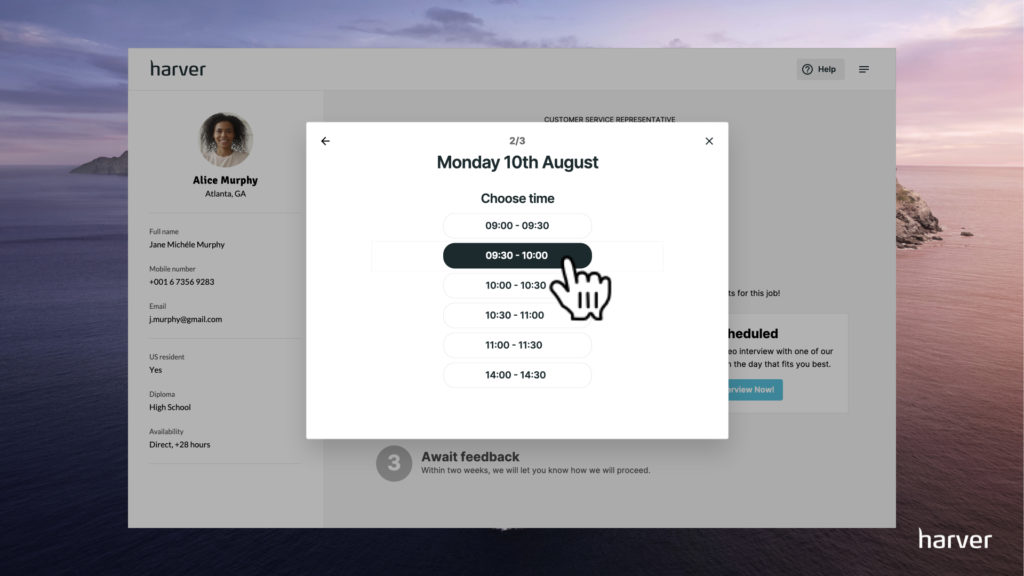
When your organization relies on consistent volume hiring, removing even the littlest issues such as interview scheduling, results in a smoother recruitment operation for all involved, as well as a better candidate experience, helping you secure the top talent before the competition.
The data
When you’re hiring at scale, you need to make automated selection decisions, based on hard data instead of biased human decisions.
There are multiple recruitment data sources you should be tracking – from tracking and analyzing key data metrics from job boards during sourcing, to collecting data and tracking applicants via your ATS and CRM, to tracking data gleaned from pre-employment assessments and interviews, all of which should fuel your hiring decisions.
But it’s not enough to simply track and collect data from these multiple sources, you need to interpret the data in order to act on it and get better business insights (BI), not just numbers.
The Harver Insights BI solution allows you to integrate all of these separate data channels, while collecting and processing the information, analyzing it, and presenting the results in a visually useful manner through a series of out-of-the-box and custom recruitment insights dashboards.
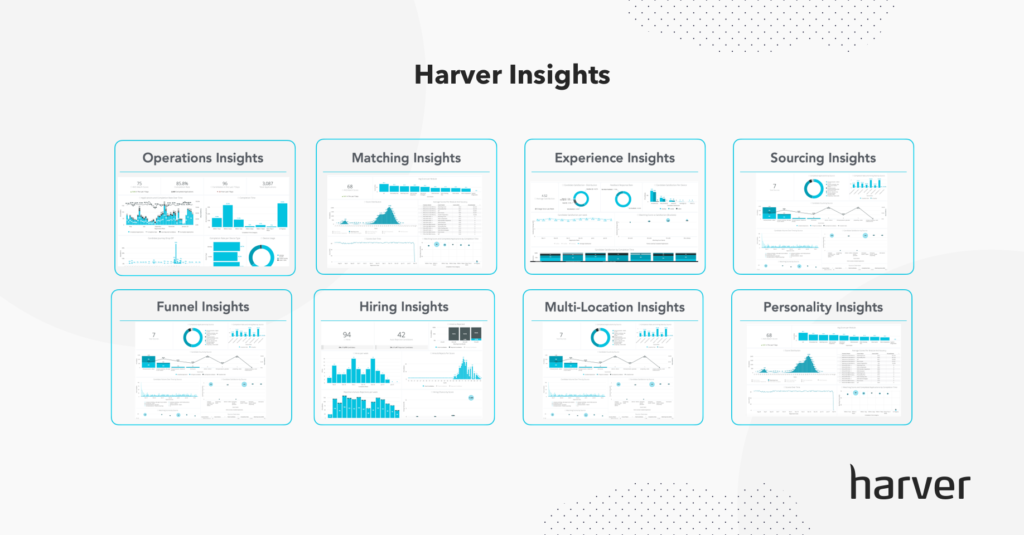
Next steps
When you need to scale hiring operations in volume recruitment, it’s crucial that you automate all elements of your hiring process to aid your recruitment efforts.
From automating sourcing to tracking applicants via your ATS, evaluating candidates with pre-employment assessments, self-scheduling interviewing and automatic onboarding processes, your entire recruitment tech stack should integrate with one another, resulting in a seamless hiring process, even at scale.
If you’d like to see how Harver can support you in improving operational efficiency in volume hiring, you can book a demo below.
Ready to transform your hiring process?


